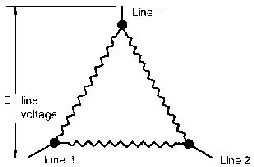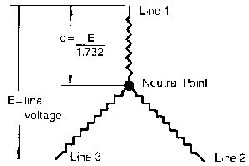|
|
| The following information
will help you to understand more about electric heating and controls.
We would recommend, however that you contact the Shuhart Company and
let us provide you with the best product for your application. |
|
Delta Wiring |
Wye or Star Wiring
|
 |
 |
| How a Electric Heater
is Made |
 |
| The most versatile of
all electric heating elements, the tubular heater is capable of being
formed into virtually any configuration. The basic design consists
of a helical coil of nickel-chromium resistance wire precisely centered
in a metal sheath. This coil is surrounded by magnesium oxide powder
which is vibration loaded to insure even density throughout the length
of the heater. This entire assembly is then reduced to the finished
diameter, compacting the MgO and "freezing" the coil in
the center of the heater. The range of ratings, sizes, materials and
terminations available makes the tubular heater adaptable to many
industrial, commercial and scientific applications. |
| Information
on Heating and Controls |
|
Technical Conversations |
| Equivalents and Conversion
charts for temperature, pressure and common conversation factors such
as celsius to fahrenheit, pounds to grams and cubic feet to cubic
meters. |
|
Glossary of Term in Thermal Applications |
| Over 10 pages of glossary
terms to help you understand industry standard terms used in the thermal
industry. |
|
Electrical Data |
| Typical wiring of controls
to heaters examples, wiring Delta and Wye configurations and amperage
charts. |
|
Formulas for Areas and Volumes |
| Formulas for calculating
areas and volumes in geometric shapes. |
|
Quick Estimate Heating Requirements |
| A quick estimate on your
heat requirement when using steel, air, water or oil. |
|
Heating Fundamentals |
| Principles of heat transfer
as it relates to conduction, convection and radiant heating. |
|
Comfort Heater Guideline |
| Application guideline
includes methods of heat transfer, heat requirements and application
tips. |
|
Comfort Heater Sizing Chart |
| Simple chart to determine
heat requirements for forced air comfort heating. |
|
Determining Heat Requirements |
| Determine heat requirements
requires good knowledge of the product to be heated and what the limitations
are in applying heat to this product. Heat loss is a big factor that
should always be considered in your heat requirements. This file includes
the basic information needed to determine your applications heat requirements. |
|
Sample Heating Applications |
| Examples of calculating
heat requirements for tank heating, platen heating and air duct heating. |
|
Determining Heat Losses |
| Determine heat losses
for insulated and uninsulated surfaces such as tanks and pipes and
losses on water and oil surfaces. |
|
Corrosion Guide for Immersion Heaters |
| The Corrosion Guide provides
suggested sheath materials for many applications. While it is by no
means complete, the guide does include all of the readily available
sheath materials and a wide variety of common chemicals and solutions.
|
|
Physical and Thermodynamic Properties of Common Liquids, Gases
and Solids |
| Charts for common liquids,
gases and solids including Specific Heat, Melting Points and Density. |
| Control
System Guidelines |
| Over 9 pages of technical pages for
design a proper thermal system including placement of sensors, sensor
types, ON/OFF verses PID controls, electronic verses mechanical controls
and SCR's verses contactors, what is the best method for your application.
|
| Thermocouple
Codes Chart |
| Information on types of thermocouples,
their wiring color codes and temperature ratings. |
| Phase-Angle
verses Zero-Crossover SCR's |
| Information on phase-angle and zero-crossover
SCR's and what might be the best mode of control for your application. |
| |
 PDF
Format requires Adobe Acrobat Reader. Click HERE to download the free
Acrobat Reader. PDF
Format requires Adobe Acrobat Reader. Click HERE to download the free
Acrobat Reader.
|



